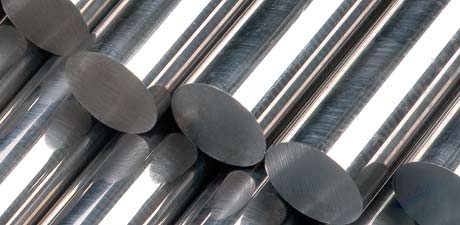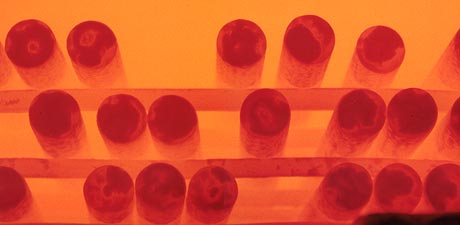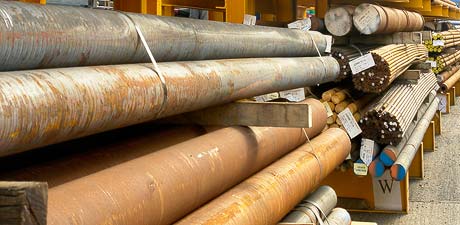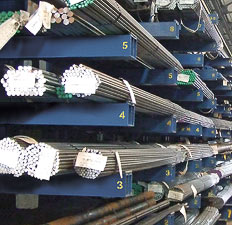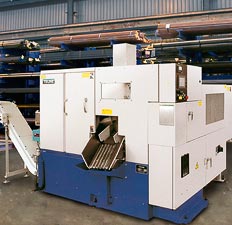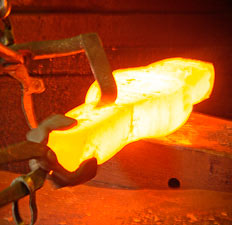Technical Data
Metallurgical Terms
Bend Test.
A test in which a standard specimen is bent through a specified arc to determine the degree of ductility and the soundness of internal structure.
Billet.
(See Bloom).
Bi.
Chemical symbol for bismuth.
Black Annealing.
A process of annealing without a protective medium.
Blast Furnace.
A tall, cylindrical, refractory-lined furnace for the production of pig iron (hot metal) which can be used directly in a steelmaking process. The furnace consists essentially of five main parts; bottom, hearth, bosh, stack and top. The bottom is composed of refractory firebrick to a depth of about 5 metres and stands on a concrete foundation; the hearth holds the accumulated molten iron and slag; the bosh is the widest part of the furnace and is also the area having the highest temperature; the stack extends from the bosh to the top and may be over 30 metres in height; the top consists of a double bell and hopper. A large pipe, known as the bustle pipe, encircles the furnace and distributes hot blast to the tuyeres, through which the hot air is blown and distributed through the furnace; the tuyeres are situated below the bosh and vary in number according to the size of the furnace. In operating the furnace, iron ore, coke and limestone are fed in at the top through the bell and hopper; as they descend through the furnace they are met by the ascending gas from the blast blown through the tuyeres. This gas in contact with the coke forms carbon monoxide which in turn reduces the iron oxide of the ore to metallic iron, the limestone forming a slag with the earthy content of the ore. (In the beginning of the campaign of the furnace, a fire is made in the hearth to provide the heat necessary to start this reaction). The molten iron and slag thus formed trickle down the furnace and collect in the hearth, the slag floating on the top of the iron. They are tapped at intervals through the iron notch and the cinder notch respectively. A modern blast furnace may have an output in excess of 10,000 tonnes of iron per day.
Bloom.
An intermediate product which has been produced by direct casting or has been produced by hot working (rolling or forging) from an ingot. A bloom is destined for further hot working to final shape and size. Blooms are over 180mm square cross section. Smaller sizes are known as billets. (See Continous Casting).
Blooming Mill.
A rolling mill used in reducing steel ingots to blooms, sometimes called a cogging mill, and not always distinguished from a billet or slab mill.
Blowholes.
(a) Round or elongated smooth walled gas-filled cavities in solid metals formed either by the trapping of gas evolved during solidifications of the metal or by steam or gas from the mould surface. (b) (Gas Pocket). A cavity in a weld caused by the entrapment of gas.
Blue Brittleness.
The loss of ductility found on testing steel in the blue heat range which varies between 200°C and 400°C according to the composition of the steel. This embrittlement is shown by the increase in maximum strength and decrease in the elongation, reduction of area and impact value. If steel is deformed at room temperature, heated in the blue heat range and then tested at normal temperatures, the loss of ductility is revealed by the impact test rather than by elongation. The term blue brittleness is derived from the fact that blue oxide films are formed on polished steel within the range of temperature in question.
Body Centred Cubic Lattice.
The crystal lattice in which atoms are present at the corners of each cube or rectangular prism, with one atom in the centre of such cube or prism. The unit cell contains two atoms, because each corner atom is shared by seven other cubes. (See Space Lattice).
Boil.
The period after melting in the production of steel, when as the carbon is being oxidized, the liberated carbon monoxide give the appearance of the metal being on the boil.
Brazing.
The process of joining two pieces of metal by fusing a layer of brass or other non-ferrous metal between the adjoining surfaces.
Bright Annealing.
A process of annealing which is carried out in a controlled furnace atmosphere or vacuum so that surface oxidation is reduced to a minimum and the surface remains relatively bright.
- < Previous
- 1
- 2
- 3
- Next >


